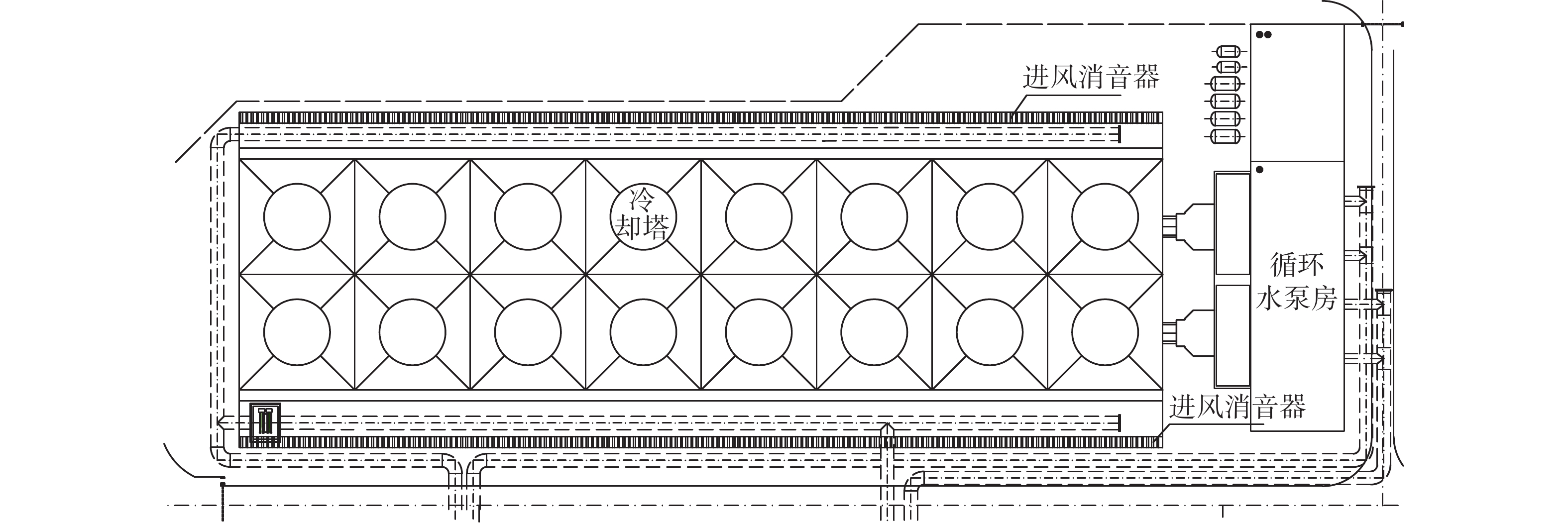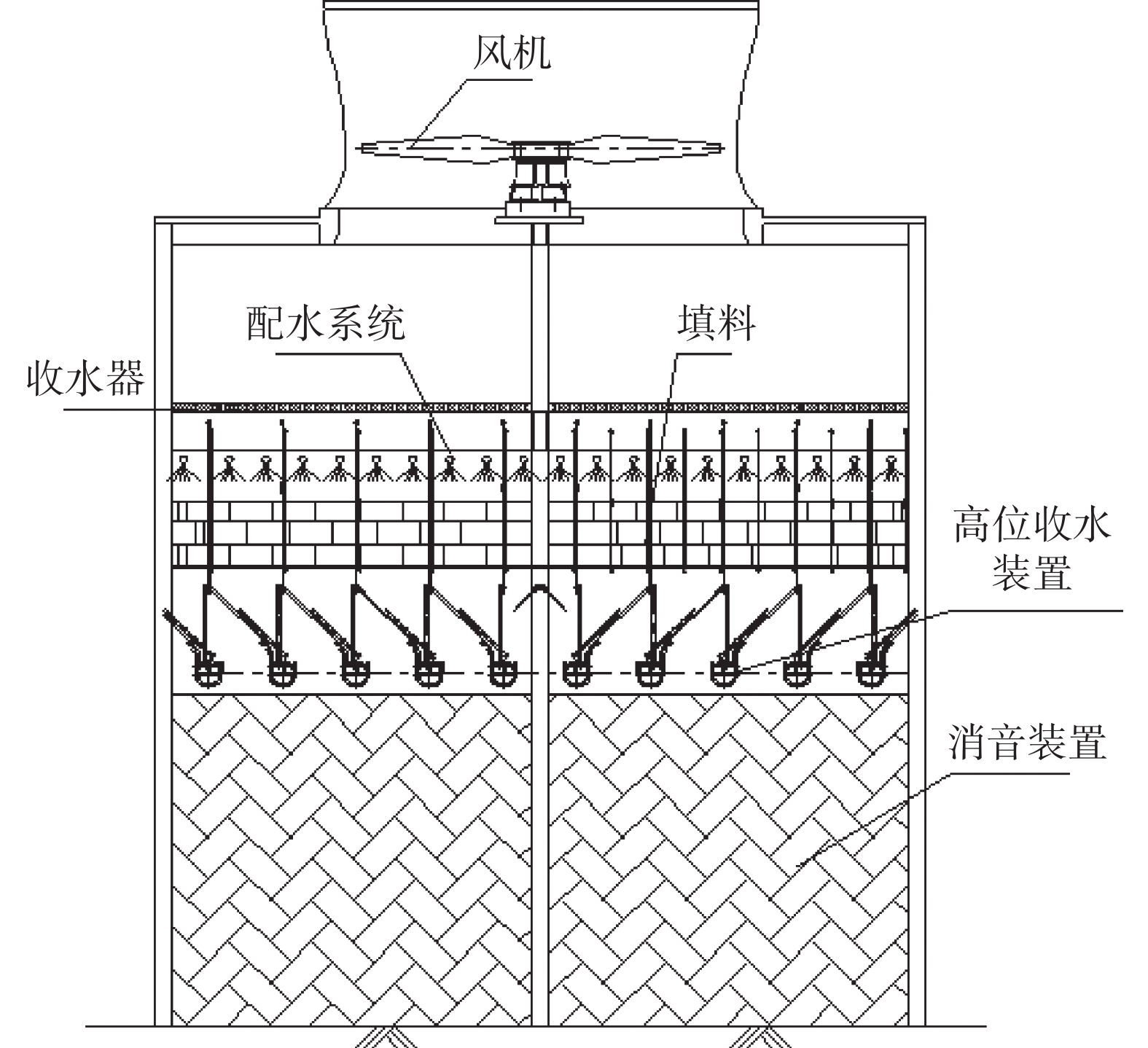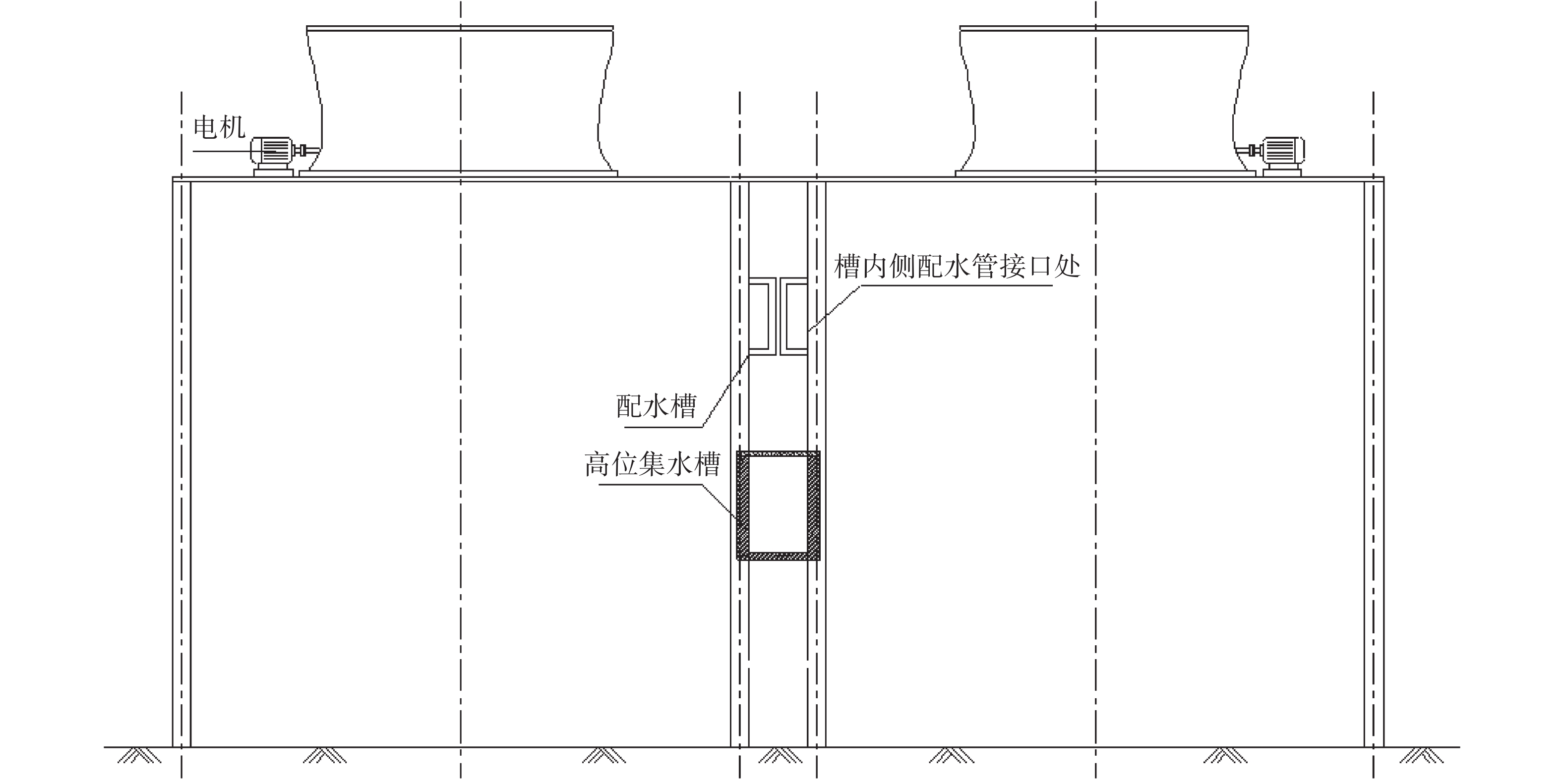-
广州某调峰电源项目地处粤港澳大湾区的核心位置,项目共有2套燃气-蒸汽联合循环机组,发电年利用小时数为3 300 h。
-
由于自然通风冷却塔工程造价远高于机械通风冷却塔,且自然通风冷却塔因体积大不利于厂区美观,厂区内也没有足够的场地进行布置,故不考虑自然通风冷却塔的方案。
-
根据厂址水源条件、机组耗水量以及设计优化结果,本工程的发电机组冷却水系统采用带逆流式机械通风冷却塔的扩大单元制循环供水方式,补给水取自珠江,水源具有较为严重的海水倒灌。1台机组配置8座机械通风冷却塔、2台变频循环水泵。
机组冷却水由机械通风冷却塔自流到循环水泵房前池,经循环水泵升压后,通过压力供水管送至凝汽器,热交换后的温排水由压力回水管流回机械通风冷却塔,在冷却塔内经过与空气换热冷却后自流回循环水泵房前池,重复循环使用。
-
1)冷却塔冷却性能要求,见表1。
序号 设计工况 干球温度/℃ 相对湿度/% 大气压/hPa 单塔冷却水/(m3·h−1) 冷幅/℃ 出塔水温/℃ 1 性能保证工况 28.4 82 1 004.2 5 850 6.90 ≤31.0 2 年平均工况 22.4 78 1 012.0 5 850 6.90 ≤27.4 3 夏季10%气象条件 25.8 95 1 002.1 5 850 6.90 ≤31.0 4 冬季工况 13.9 73 1 019.8 5 850 8.33 ≤22.0 Table 1. Cooling performance requirements for cooling tower
2)冷却塔分成两排东西向布置,塔排“背靠背”布置在厂区北侧。本项目东侧厂界外为未开发商业用地,西侧和北侧厂界外为已有工业区,冷却塔排离南侧厂界超过100 m。
3)为提升厂区内外景观效果,不在厂界围墙处设置隔声屏障。为保证厂址地区的环境要求,厂界噪声标准为昼间≤65 dB(A),夜间≤55 dB(A)。
4)冷却塔进风口外1 m处噪声值不高于70 dB(A),风机排口45°方向外1 m噪声值不高于80 dB(A),风机电机沿轴线45°方向外1 m噪声值不高于80 dB(A)。
5)上述出塔水温要求均应考虑降噪措施的影响,本项目部分冷却塔的进风口设置有消声装置,热力计算过程中预留不小于30 Pa的阻力损失。
-
本文仅对基于相同冷却效果下机械通风冷却塔的型式进行对比分析,不对冷却塔的布置方式进行分析。依据全厂布置格局、燃机进气、降噪投资等方面的优化设计,冷却塔布置方式采用“冷却塔东西布置+塔排背靠背”的布局方案。在此条件下,拟定两种单侧进风机械通风冷却塔进行比选,即单面进风常规塔和单面进风高位收水塔。
-
单面进风常规塔的单塔内部结构图和塔群平面布置图如图1和图2所示。工艺原理如下:凝汽器出来的温排水通过压力回水管进入塔内,自上而下分别经配水区、填料区和雨区,与逆向流动的空气进行换热后冷却,下落至冷却塔下部集水池,完成冷却水的收集过程。
本方案集水池需地下布置,循环水泵和进水前池需地下布置,循环水泵房需半地下布置,循环水压力回水管需在塔群四周布置。冷却塔排距离东侧厂界约68 m(不含循环水泵房)。
冷却水经雨区落入集水池中产生水击噪声[超过85 dB(A)],是冷却塔主要噪声来源之一,对周边环境影响较大。为减小冷却塔噪声影响需在所有冷却塔进风口设置进风消音器,同时需在所有冷却塔的出风口设置降噪墙。
-
本方案的单塔内部结构图、塔群平面布置图和侧视图分别如图3、图4和图5所示。高位收水塔与常规塔相比,塔芯部件的安装方式有变化,除了除水器是搁置在土建梁顶,其他的常规配水系统与淋水填料都采用悬吊的形式,增加的收水装置同样采用悬吊结构安装在填料层下方。高位收水装置包括收水槽、收水斜板、不锈钢悬吊件、不锈钢上下挂梁、挡水板、防溅器等部件。
本方案高位收水塔取消了淋雨和常规塔底部的混凝土集水池,收水(集水)装置位置大幅上提,集水槽布置在两塔之间,相邻两列冷却塔共用同一高位集水槽。冷却塔排距离东侧厂界约45 m。
-
1) 高位收水塔节能的关键在于减少了常规塔淋雨自由跌落的高度,这个高度等于循环水系统节约的水头,即循环水泵减少的静扬程。
2) 循环水泵无需地下布置,采用地上布置,降低了循环水泵扬程。
3) 冷却塔底部无集水池,循环水压力回水管可从塔底直接穿过。循环水管管路更短捷,进一步降低水泵扬程。
4) 循环水泵房全地上布置,减轻循环水泵汽蚀,提高了循环水泵的安全性和检修便利性。
5) 冷却塔增加的收水装置,增加了一部分阻力,但与减小的雨区阻力和减少的进风口阻力相比,可视为相当。
6) 运行能耗对比
① 常规塔方案:循环水泵扬程~26 m,循环水泵单台轴功率~1.931 MW(电机功率~2.2 MW),4台总轴功率:~7.724 MW。
② 高位收水塔方案:循环水泵扬程~19.5 m,循环水泵单机功率~1.378 MW(电机功率~1.7 MW),4台总轴功率~5.512 MW。
对比来看,高位收水塔方案相比常规塔方案减少循环水泵扬程~6.5 m,节约循泵总功率高达~2.212 MW,每年节省用电超过7.29 GWh,节能效果显著。高位收水塔方案更优。
-
常规塔,由于风速影响及水池的消能作用,通过填料后的水流自由跌落(即雨区)至集水池所产生的动能被全部损耗,同时产生很大的噪声。高位收水塔通过填料下端的收水斜板和收水槽,将水汇集到高位集水槽。高位集水槽水面到填料底部的高差远小于常规塔雨区的高度,即高位收水塔从填料底部通过收水斜板及收水槽损失的能量远小于常规塔雨区损失的能量,相应产生的噪声更小。另外收水斜板上铺设的防溅填料也可以在一定程度上降低一部分噪声。
整体来说,高位收水装置可减少冷却塔本体噪声15~20 dB(A)。
为满足厂界和冷却塔区噪声要求,根据噪音模拟研究,对于常规塔,所有冷却塔均需设置进风消声器;而对于高位收水塔,仅需对靠东侧的6座冷却塔设置进风消音器。
-
1) 常规塔进风口有飘滴,由于本工程是咸淡水,可能会对冷却塔周边(如锅炉区域)的金属结构有影响。高位收水塔几乎无飘滴影响。
2) 高位收水塔能与循环水泵房联合布置,同时进风消音器及循环水回水管能塔内布置,有利于厂区美观,冷却塔区域总占地面积更小。相对常规塔,高位收水塔区域(包括冷却塔、进风消音器、水池、循环水泵房)总占地面积小近3 000 m2。
-
参数 项目 常规塔 高位收水塔 备注 性能参数 单台冷却水量/(q·m−3·h−1) 5 850 5 850 — 水温降/°C 6.9 6.9 — 出塔水温/°C 31 31 性能保证工况 26 26 年平均气象条件 风机直径/m 10.4 10.4 — 配用电机功率/kW 250 250 高位收水塔总的通风阻力与常规塔相比整体相当或略有降低,暂按相当考虑。 塔型参数 单塔平面尺寸/m 20.5×21.5 20.5×21.5 — 进风口高度/m 8.8 8.8 — 配水管高度/m 12.1 15.2 由于布置高位收水装置,高位收水塔需总体抬高。
两个方案冷却塔出风口均设置混凝土隔声墙。风机平台高度/m 17.6 21.8 塔总高度/m 25.6 29.8 单塔本体占地面积/m2 441 441 不含进风消音器 冷却塔区域总占地面积/m2 12 184 9 225 含冷却塔、进风消音器、水池、循环水泵房 Table 2. Preliminary process design parameters of two types of towers
-
对上述两种塔型方案的初期投资和年运行费用进行综合比较,见表3。
序号 项目 常规塔 高位收水塔 备注 1 初期投资(万元) 0 1 240.0 — 1.1 高位收水装置造价 0 1 920.0 高位收水塔增加收水装置 1.2 冷却塔土建造价 0 920.0 高位收水塔需整体加高约4 m,因新增集水槽需加大梁柱。仅取消地下集水池。 1.3 循环水泵造价 0 −200.0 高位收水塔配套的循环水泵扬程降低,电机及变频器功率降低。 1.4 其他辅助设备造价 0 −40.0 循环水前池取消了平板滤网及电动葫芦,以及循泵房取消了排水泵。 1.5 循环水管造价 0 −330.0 高位收水塔配套的循环水管比常规塔配置的短约340 m。 1.6 循泵房土建造价 0 −350.0 高位收水塔配套的循环水前池和循泵房土方开挖工程量大幅减少,但需增加
循环水前池地上布置以及循泵房地上部分加高的工程量。1.7 降噪造价 0 −680.0 高位收水塔配套的进风口消音器工程量减少。 2 年运行总费用(万元) −281.6 — 2.1 循环水泵功耗电费 0 −361.6 按成本电价0.496元/(kW·h)计,年利用小时数3 300 h。 2.2 冷却塔检修维护费用 0 80.0 高位收水塔检修维护工作量较大,按高位收水塔的比常规塔高5万/年考虑。 3 年费用值(万元) 0 −93.1 按DL/T 5339-2018《火力发电厂水工设计规范》规定投资回收率取10%,
大修费率取3.5%,年固定分摊费率15.2%。Table 3. Economic comparison of two tower schemes
-
虽然高位收水塔方案比常规塔方案的初期投资高1 240万元,但高位收水塔方案节电显著,年运行费用少281.6万元,使得其初期投资增加的费用在4年多即可收回。同时,高位收水塔方案比常规塔方案的年费用值低93.1万元,说明寿命期内经济效益更佳。
-
在保证相同冷却效果的前提下,对比两种机械通风冷却塔塔型方案的结构、技术、经济方面特征,单面进风高位收水塔相对单面进风常规塔更具有多方面的优势。机械通风冷却塔采用高位收水技术,适合大型背靠背布置塔型,在用地寸土寸金的区域可节约用地;消除了大部分淋水噪声,大幅降低循环水泵扬程,并配备变频循环水泵,满足不同工况的冷却水量需求,降低厂用电率,节能效果明显。
Application of High Level Water Collecting Mechanical Draft Cooling Tower in Power Plant
doi: 10.16516/j.gedi.issn2095-8676.2022.S2.005
- Received Date: 2022-02-20
- Accepted Date: 2022-07-30
- Rev Recd Date: 2022-06-15
- Available Online: 2023-01-04
- Publish Date: 2023-01-04
-
Key words:
- thermal power plant /
- mechanical draft cooling tower /
- high level water collecting technology /
- energy saving /
- noise reduction /
- annual operating cost
Abstract:
| Citation: | CHEN Guangchuan, ZHANG Guogang, ZHANG Ying. Application of High Level Water Collecting Mechanical Draft Cooling Tower in Power Plant[J]. SOUTHERN ENERGY CONSTRUCTION, 2022, 9(S2): 24-30. doi: 10.16516/j.gedi.issn2095-8676.2022.S2.005 |




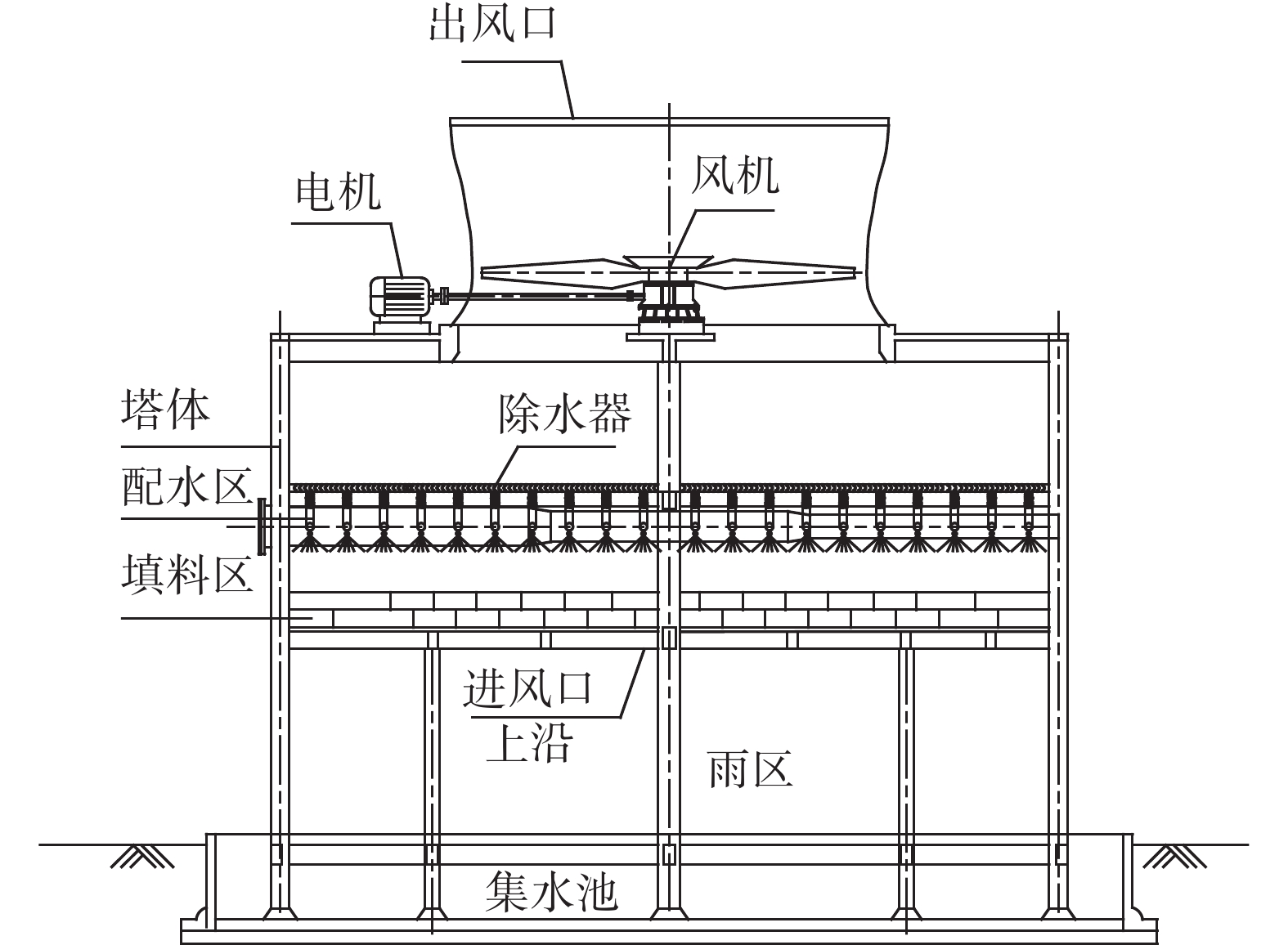

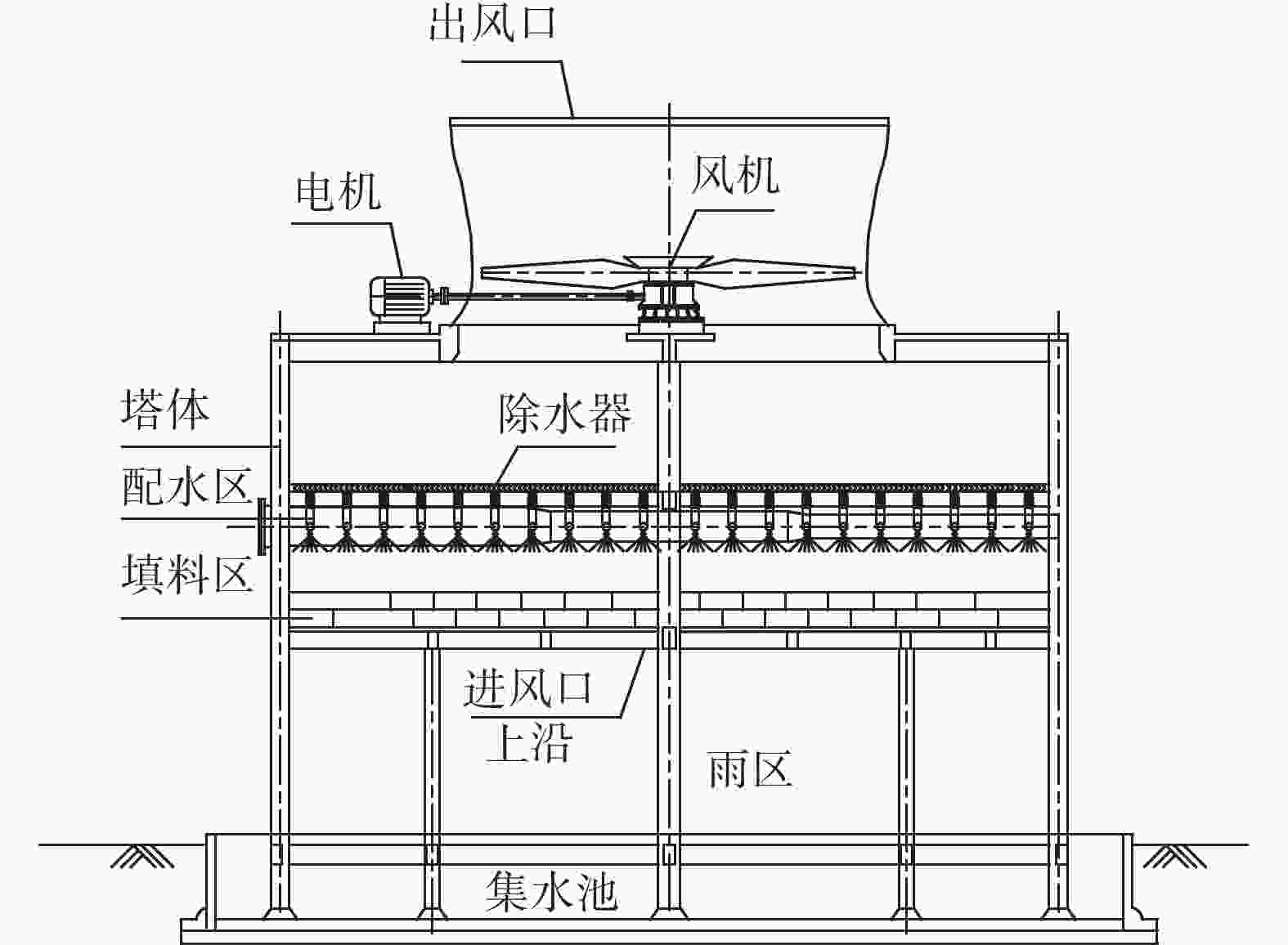
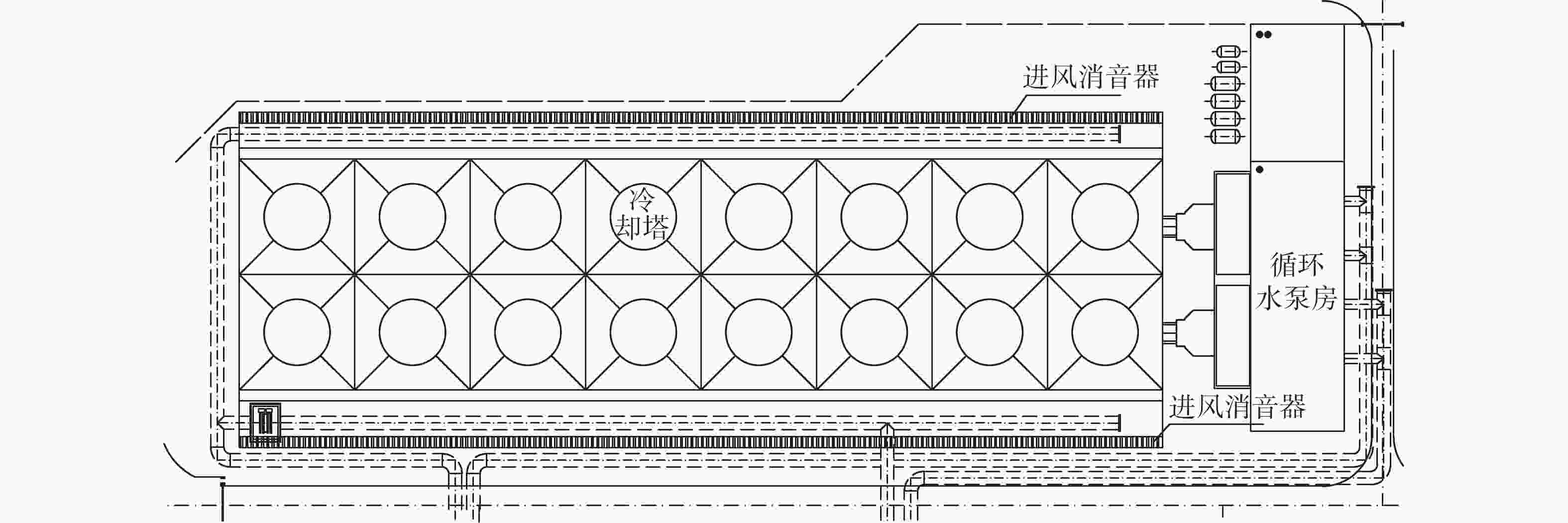
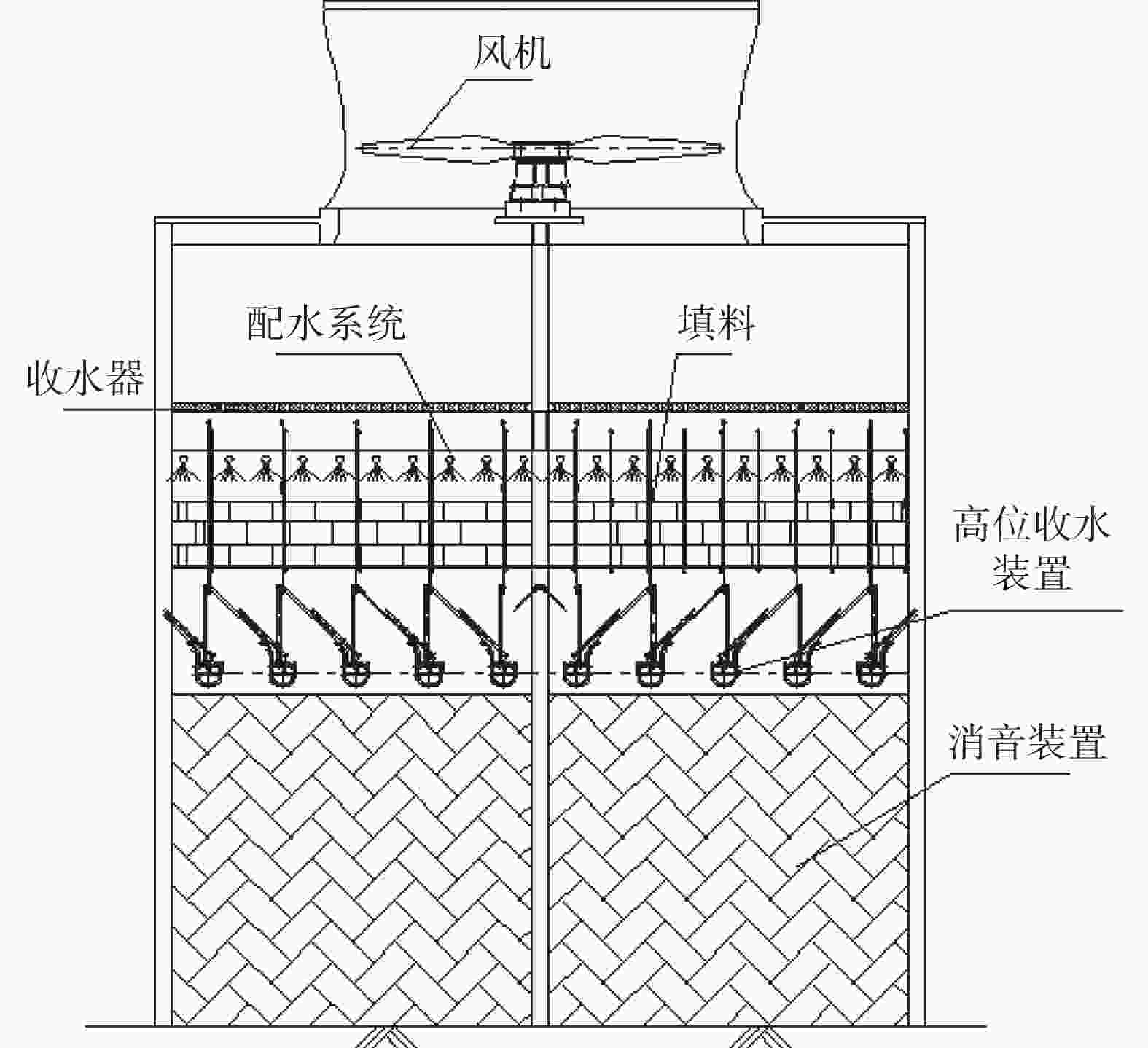

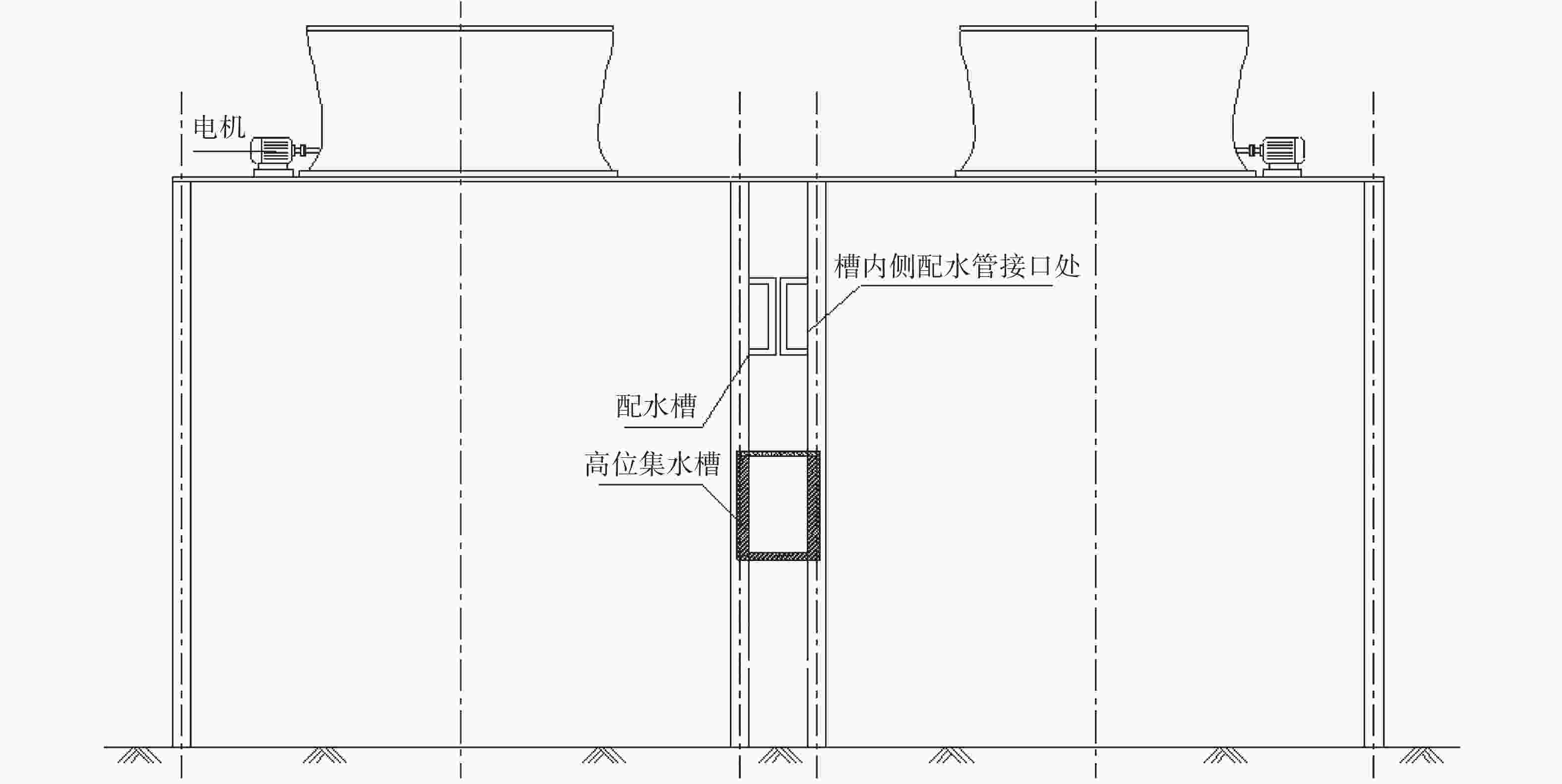

 DownLoad:
DownLoad:
